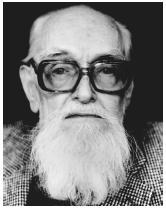Archer John Porter Martin
ENGLISH BIOCHEMIST
1910–2002
Very few chemical reactions produce clean, pure products with no trace of starting materials or impurities. Most generate a mixture whose individual components must be purified before the results can be identified. In the nineteenth and early twentieth centuries, purification of a chemical reaction product often required repetitive crystallizations, distillation, or solvent extraction.

Archer John Porter Martin grew up in London, England, and from an early age demonstrated an aptitude for chemistry. As a child, he designed and built an apparatus for distillation from old coffee tins packed with charcoal, some as tall as five feet. He entered Cambridge University with the intention of pursuing a degree in chemical engineering. However, he was influenced by J. B. S. Haldane to specialize in biochemistry. At Cambridge his childhood experience with fractional distillation became valuable.
Martin continued with his explorations of multi phase separation technology and went to work as a research chemist for the Wool Industries Research Association in Leeds. It was there that he met Richard Lawrence Millington Synge and began to collaborate with Synge on the problem of separating acetylamino acids. Eventually, Martin and Synge came up with the idea that, instead of using a counterflow extraction process with solvents moving against one another, they could partition one phase (hold one phase stationary using an appropriate support). The result was the invention of liquid-liquid partition chromatography , first reported in the Biochemistry Journal in 1941.
In their landmark paper, Martin and Synge also indicated that partition chromatography that used a carrier gas as the mobile phase was possible. In his Nobel lecture of 1952, Martin casually revealed that he, in collaboration with A. T. James, had devised a mechanism for gas-liquid chromatography. The use of a gas as the mobile phase did place limits on the types of material that could be analyzed, as the compounds had to be volatile and better detectors were needed, but these difficulties proved to be surmountable. Today, gas-liquid chromatography is probably the single most widely used analytical tool in chemistry.
SEE ALSO Analytical Chemistry ; Synge, Richard Laurence Millington .
Todd W. Whitcombe
Bibliography
Martin, Archer J. P., and Synge, Richard L. M. (1941). Biochemistry Journal 35: 1358–1366. American Chemical Society and the Chemical Heritage Foundation.
Shetty, Prabhakara H. (1993). "Archer John Porter Martin." In Nobel Laureates in Chemistry 1901–1992, ed. Laylin K. James. Washington, DC: American Chemical Society and the Chemical Heritage Foundation.
Internet Resources
Nobel e-Museum. "Archer John Porter Martin—Biography." Available from http://www.nobel.se .
Comment about this article, ask questions, or add new information about this topic: